Earle Page
| The Right Honourable Sir Earle Page GCMG, CH | |
|---|---|
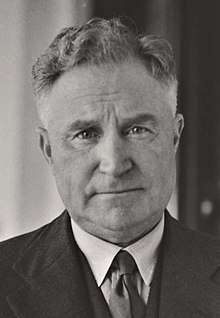 | |
| 11th Prime Minister of Australia | |
|
In office 7 April 1939 – 26 April 1939 | |
| Monarch | George VI |
| Governor-General | Lord Gowrie |
| Preceded by | Joseph Lyons |
| Succeeded by | Robert Menzies |
| Leader of the Country Party Elections: 1922, 1925, 1928, 1929, 1931, 1934, 1937 | |
|
In office 5 April 1921 – 13 September 1939 | |
| Deputy |
List
Henry Gregory 1921-1922 William Fleming 1922 William Gibson 1923-1929 Thomas Paterson 1929-1937 Harold Thorby 1937-1939 |
| Preceded by | William McWilliams |
| Succeeded by | Archie Cameron |
| Treasurer of Australia | |
|
In office 9 February 1923 – 21 October 1929 | |
| Prime Minister | Stanley Bruce |
| Preceded by | Stanley Bruce |
| Succeeded by | Ted Theodore |
| Minister for Commerce | |
|
In office 9 November 1932 – 26 April 1939 | |
| Prime Minister |
Joseph Lyons Earle Page |
| Preceded by | Frederick Stewart |
| Succeeded by | George McLeay |
|
In office 28 October 1940 – 7 October 1941 | |
| Prime Minister |
Robert Menzies Arthur Fadden |
| Preceded by | Archie Cameron |
| Succeeded by | William Scully |
| Minister for Health | |
|
In office 29 November 1937 – 7 November 1938 | |
| Prime Minister | Joseph Lyons |
| Preceded by | Billy Hughes |
| Succeeded by | Harry Foll |
|
In office 19 December 1949 – 11 January 1956 | |
| Prime Minister | Robert Menzies |
| Preceded by | Nick McKenna |
| Succeeded by | Donald Cameron |
| Member of the Australian Parliament for Cowper | |
|
In office 13 December 1919 – 9 December 1961 | |
| Preceded by | John Thompson |
| Succeeded by | Frank McGuren |
| Personal details | |
| Born |
Earle Christmas Grafton Page 8 August 1880 Grafton, New South Wales, Australia |
| Died |
20 December 1961 (aged 81) Camperdown, New South Wales, Australia |
| Political party | Country |
| Spouse(s) |
Jean Thomas (m. 1959) |
| Children | 5 |
| Relatives |
Robert Page (nephew) Geoffrey Page (grandson) Donald Page, Jr. (grandson) |
| Education |
Grafton Public School Sydney Boys High School |
| Alma mater | University of Sydney |
| Occupation | Doctor, surgeon, politician |
Sir Earle Christmas Grafton Page, GCMG, CH (8 August 1880 – 20 December 1961) was an Australian politician who served as the 11th Prime Minister of Australia, holding office for 19 days after the death of Joseph Lyons in 1939. He was the leader of the Country Party from 1921 to 1939, and was the most influential figure in its early years.
Page was born in Grafton, New South Wales. He entered the University of Sydney at the age of 15, and completed a degree in medicine at the age of 21. After completing his residency at Sydney's Royal Prince Alfred Hospital, he moved back to Grafton and opened a private hospital. He soon became involved in local politics, and in 1915 purchased a part-share in The Daily Examiner, a local newspaper. He also briefly served as a military surgeon during World War I. Page gained prominence as an advocate of various development schemes for the Northern Rivers region, especially those involving hydroelectricity. He also helped found a movement for New England statehood.
In 1919, Page was elected to federal parliament representing the Division of Cowper. He joined the new Country Party the following year as its inaugural whip, and then replaced William McWilliams as party leader in 1921. Page opposed the economic policies of Prime Minister Billy Hughes, and when the Country Party gained the balance of power at the 1922 election, he demanded Hughes' resignation as the price for a coalition with the Nationalist Party. He was subsequently made Treasurer under the new prime minister, Stanley Bruce, serving in that role from 1923 to 1929. He had a significant degree of influence on domestic policy, with Bruce concentrating on international issues.
Page returned to cabinet after the 1934 election, when the Country Party entered a new coalition with Joseph Lyons' United Australia Party. He was appointed Minister for Commerce, and concentrated on agricultural issues. When Lyons died in office in April 1939, Page was commissioned as his successor in a caretaker capacity while the UAP elected a new leader, Robert Menzies. Page subsequently refused to serve in Menzies' cabinet, withdrawing the Country Party from the coalition, but this proved unpopular and he resigned the party leadership after a few months. The coalition was eventually reconstituted, and Page served again as Minister for Commerce under Menzies and Arthur Fadden until the government's defeat in October 1941.
Page's last major role was as Minister for Health (1949–1956) in the post-war Menzies Government. He retired from cabinet at the age of 76, and died a short time after losing his seat at the 1961 election. Page served in parliament for almost 42 years, and only Menzies lasted longer as the leader of a major Australian political party. He secured his party's independence by refusing overtures to join the Nationalists and the UAP, and the policies that he favoured – decentralisation, agrarianism, and government support of primary industry – have remained the basis of its platform up to the present day. The coalitions that he established and maintained with Bruce and Lyons have served as a model for all subsequent coalition governments.
Early life
Birth and family background
Earle Christmas Grafton Page was born in Grafton, New South Wales, on 8 August 1880. His first middle name, which he disliked, was given to him to carry on the surname of a childless relative, while his second middle name was in honour of his birthplace. Page was the fifth of eleven children born to Charles Page and Mary Johanna Haddon (Annie) Cox.[1] His parents had both lived in Grafton since they were children. His mother was born in Tasmania to an English father and a Scottish mother. His father, born in London, was a successful businessman and a member of the Grafton City Council, serving a single term as mayor in 1908. The family business was a hardware manufacturing firm, which had its origins in a coachbuilding firm established in 1858 by Page's maternal grandfather, Edwin Cox.[2] His other grandfather, James Page, arrived in Grafton in 1855, serving as the town's first schoolmaster and first town clerk.[3]
Education
Page began his schooling at Grafton Public School, where he excelled academically. His family could not afford to send him to boarding school, as a result of financial difficulties caused by the banking crisis of 1893. Page consequently had to rely on scholarships to advance his education.[4] He won a bursary to attend Sydney Boys High School in 1895, where he passed the university entrance exams, and the following year – aged 15 – began studying a liberal arts course at the University of Sydney. He was equal top in mathematics in his first year, and was also awarded the lucrative Struth Exhibition for "general proficiency in the arts", which allowed him to switch to medicine and covered his first four years of medical school.[5] His role model was Grafton Smith, who had followed a similar path from Grafton Public School to university.[6] At Sydney Medical School, Page's lecturers included William Haswell (biology), James Hill (biology), Charles Martin (physiology), Anderson Stuart (physiology), and James Wilson (anatomy).[7] He graduated at the top of his class in 1901, with the degrees of Bachelor of Medicine (M.B.) and Master of Surgery (Ch.M.).[8]
Medical career
Page's first professional posting came before he had even been registered as a medical practitioner. Due to a shortage of doctors, he was acting superintendent of the Royal Alexandra Hospital for Children for one month.[9] In 1902, he took up a position as a resident at the Royal Prince Alfred Hospital, serving in a variety of roles including as house surgeon under Robert Scot Skirving. During that time he contracted a near-fatal infection from a postmortem examination.[10] He also met his future wife, nurse Ethel Blunt.[11] Page returned to his home town in 1903, taking over a practice in South Grafton. He and two partners subsequently established a new private hospital, Clarence House Hospital, which opened in 1904 and served both Grafton and the surrounding region.[12]
Page was a keen adopter of new technologies. In 1904, he bought what he claimed was "the first Rover car in Australia", which was powered by kerosene.[13] He upgraded to an Itala in 1908, and had the chassis enlarged so it could be used as an ambulance. He also had an x-ray machine installed in his hospital, one of the first in Australia outside a major city.[14] Page developed a reputation for surgical innovation, taking a number of patients from Sydney and even some from interstate. One operation that brought him particular fame was the removal of a patient's diseased lung, a procedure that had only been invented a few years previously.[15] Page became an inaugural Fellow of the Royal Australasian College of Surgeons (FRACS) in 1927, and in 1942 was made an honorary Fellow of the Royal College of Surgeons of England (FRCS).[16]
In February 1916, Page enlisted in the Australian Army Medical Corps. He served as chief medical officer aboard the troopship HMAT Ballarat, and was then stationed at an army hospital in Cairo for several months. He was transferred to a hospital in England in July 1916, and concluded his service as a surgical specialist at a casualty clearing station in France. Page returned to Australia in March 1917 and was discharged from the military in July 1917.[16] Although his active involvement in medicine declined as his political career progressed, he was frequently called upon to treat his fellow MPs or parliamentary staff. This was particularly true after the federal government moved to Canberra, as the new capital had only a handful of qualified surgeons. In 1928, for instance, he performed an emergency appendectomy on Parker Moloney.[17]
Early political involvement
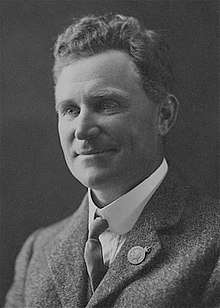
Page's medical career brought him considerable wealth, and he began investing in land. He bought several large farming properties in South-East Queensland, including in Nerang, Kandanga, and the Numinbah Valley; Pages Pinnacle in the Numinbah State Forest is named after him.[18] His entry into public life came about as a result of his passion for hydroelectricity, which he first observed in New Zealand while attending a medical convention in 1910. He believed that it could be applied to the Northern Rivers region, which was still mostly unelectrified outside of the major towns. Page was elected to the South Grafton Municipal Council in 1913, believing his position as an alderman would be useful in his lobbying efforts. However, his overtures to the state government were rebuffed. In 1915, Page was one of the founders of the Northern New South Wales Separation League, which advocated the creation of a new state in the New England region. He toured a number of towns to raise awareness of the new movement, but interest waned as a result of the ongoing war. Later that year, he was part of a syndicate that bought The Daily Examiner, the local newspaper in Grafton.[19]
Page visited a number of hydroelectric sites in North America in 1917, on his way back from military service in France. He was elected mayor of South Grafton in 1918, serving until 1920, and also became the inaugural president of the North Coast Development League. He developed more concrete plans for a hydroelectric project on the Clarence River, and put forward various other development schemes relating to roads, railways, and ports, all of which served to raise his profile in the local district. Page was elected to the House of Representatives at the 1919 federal election, defeating the sitting Nationalist MP, John Thomson in the Division of Cowper. He stood as an independent with the endorsement of the Farmers' and Settlers' Association, and after the election joined the new Country Party, along with 10 other MPs from rural seats. Page continued to advocate for hydroelectricity throughout his political career, and many such projects were built in New South Wales. However, the specific scheme he favoured for the Clarence River was never put in place, only the smaller Nymboida Power Station. Decentralisation also remained a pet project, with Page frequently arguing for New South Wales and Queensland to be divided into smaller states to aid regional development. The movement for New England statehood waned in the 1920s, but re-emerged in the 1950s; a legally binding referendum on the subject was finally held in 1967, after Page's death, but was narrowly defeated in controversial circumstances.[19]
Bruce–Page Government
Page was elected leader of the Country Party in 1921, replacing William McWilliams. The fledgling Country Party found itself with the balance of power in the House after the 1922 election. The Nationalist government of Billy Hughes lost its majority, and could not govern without Country Party support. It soon became apparent that the price for that support would be a full coalition with the Nationalists. However, the Country Party had been formed partly due to discontent with Hughes' rural policy, and Page's animosity toward Hughes was such that he would not even consider supporting him. Indeed, he would not even begin talks with the Nationalists as long as Hughes remained leader. Bowing to the inevitable, Hughes resigned.[20]
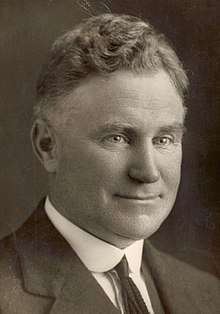
Page then began negotiations with Hughes' successor as leader of the Nationalists, Stanley Bruce. His terms were stiff; he wanted his Country Party to have five seats in an 11-man cabinet, including the post of Treasurer and the second rank in the ministry for himself. These demands were unprecedented for a prospective junior coalition partner in a Westminster system, and especially so for such a new party. Nonetheless, Bruce agreed rather than force another election.[20] For all intents and purposes, Page was the first Deputy Prime Minister of Australia (a title that did not officially exist until 1968). Since then, the leader of the Country/National Party has been the second-ranking member in nearly every non-Labor government.
On 30 January 1924, as acting prime minister, Page chaired the first meeting of Federal Cabinet ever held in Canberra, at Yarralumla.[21][22] This was still three years before the opening of Parliament House and Canberra becoming the National Capital.
Page continued his professional medical practice. On 22 October 1924, he had to tell his best friend, Thomas Shorten Cole (1870–1957), the news that his wife Mary Ann Crane had just died on the operating table from complications of intestinal or stomach cancer, reputed by their daughter Dorothy May Cole to be "the worst day of his life".
He was a strong believer in orthodox finance and conservative policies, except where the welfare of farmers was concerned: then he was happy to see government money spent freely. He was also a "high protectionist": a supporter of high tariff barriers to protect Australian rural industries.[19][23]
Opposition and Lyons Government
The Bruce-Page government was heavily defeated by Labor in 1929 (with Bruce losing his own seat), and Page went into opposition. In 1931, a group of dissident Labor MPs led by Joseph Lyons merged with the Nationalists to form the United Australia Party under Lyons' leadership. Lyons and The UAP–Country Coalition won a comprehensive victory in the 1931 election. However, the UAP came up four seats short of a majority, and was able to secure a bare majority when the Emergency Committee of South Australia joined forces with the UAP. Although Lyons was keen to form a coalition with the Country Party, talks broke down, and Lyons opted to govern alone—to date, the last time that the Country/National Party has not had any posts in a non-Labor government. In 1934, however, the UAP suffered an eight-seat swing, forcing Lyons to take the Country Party back into his government in a full-fledged Coalition. Page became Minister for Commerce. He was made a Knight Grand Cross of the Order of St Michael and St George (GCMG) in the New Year’s Day Honours of 1938.[24] While nine Australian Prime Ministers were knighted (and Bruce was elevated to the peerage), Page is the only one who was knighted before becoming Prime Minister.
Prime Minister and aftermath
.png)
When Lyons died suddenly in 1939, the Governor-General Lord Gowrie appointed Page as caretaker Prime Minister pending the UAP choosing a new leader. He held the office for three weeks until the UAP elected former deputy leader Robert Menzies as its new leader, and hence Prime Minister.[25]
Page had been close to Lyons, but disliked Menzies, whom he charged publicly with having been disloyal to Lyons. When Menzies was elected UAP leader, Page refused to serve under him, and made an extraordinary personal attack on him in the House, accusing him not only of ministerial incompetence but of physical cowardice (for failing to enlist during World War I). His party soon rebelled, though, and Page was deposed as Country Party leader in favour of Archie Cameron.[25]
In 1940 Page and Menzies patched up their differences for the sake of the war effort, and Page returned to the cabinet as Minister for Commerce.[19] Nevertheless, Page's accusations were not forgotten and were occasionally raised in parliament by Menzies' opponents (notably Eddie Ward). In 1941, the government fell; and Page spent the eight years of the Curtin and Chifley Labor governments on the opposition backbench.[26] He was made a Companion of Honour (CH) in June 1942.[27]
Return to the ministry
Menzies returned to the prime ministership in 1949, and Page was made Minister for Health. He oversaw the passage of the National Health Act 1953. He retired from cabinet at the age of 76, moving to the backbench in 1956.[28] Upon the death of Billy Hughes in October 1952, Page became the Father of the House of Representatives and Father of the Parliament.[29]
Later life and death
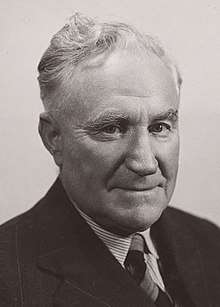
Page was the first Chancellor of the University of New England, which was established in 1954.[28]
By the 1961 election, Page was gravely ill, suffering from lung cancer. Although he was too sick to actively campaign, Page refused to even consider retiring from Parliament and soldiered on for his 17th general election. In one of the great upsets of Australian electoral history, he lost his seat to Labor challenger Frank McGuren, whom he had defeated soundly in 1958. Page had gone into the election holding Cowper with what appeared to be an insurmountable 11-point majority, but McGuren managed to win the seat on a swing of 13%.
Page had campaigned sporadically before going to Royal Prince Alfred Hospital in Sydney for emergency surgery. He went comatose a few days before the election and never regained consciousness. He died on 20 December, 11 days after the election, without ever knowing that he had been defeated.[19][30]
Page had represented Cowper for just four days short of 42 years, making him the longest-serving Australian federal parliamentarian who represented the same seat throughout his career. Only Billy Hughes and Philip Ruddock have served in Parliament longer than Page,[31].
Personal life

Page married Ethel Blunt on 18 September 1906. They had met at Royal Prince Alfred Hospital while he was undertaking his medical residency; she was a senior nurse there. Page soon began courting her, and convinced to become the matron of his new hospital in Grafton. She gave up nursing after their marriage, but was active in politics and community organisations. The couple had five children: Mary (b. 1909), Earle Jr. (b. 1910), Donald (b. 1912), Iven (b. 1914), and Douglas (b. 1916). Their grandchildren include Don Page, who was active in New South Wales state politics, and Geoff Page, a poet.[11]
Page was predeceased by his first wife and his oldest son. Earle Jr., a qualified veterinarian, was killed by a lightning strike in January 1933, aged 22.[32] Ethel died in May 1958, aged 82, after a long illness.[33] On 20 July 1959 at St Paul's Cathedral, London, Page married for a second time, wedding his long-serving secretary Jean Thomas (32 years his junior). Stanley Bruce was his best man.[19] The second Lady Page lived for almost 50 years after her husband's death, dying on 20 June 2011; her ashes were interred at Northern Suburbs Crematorium.[34]
Honours
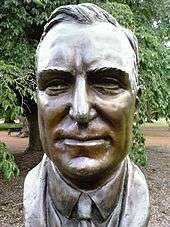
- Decorations
- In 1929, Page was made a member of the Privy Council of the United Kingdom (PC).
- In 1938, Page was made a Knight Commander of the Order of St Michael and St George (KCMG).
- In 1942, Page was made a member of the Order of the Companions of Honour (CH).
- In 1942, Page was made an honorary Fellow of the Royal College of Surgeons of England (FRCS).
- In 1952, Page was awarded the degree of Doctor of Science honoris causa by the University of Sydney.
- In 1955, Page was awarded the degree of Doctor of Science honoris causa by the University of New England (the first honorary degree awarded by the institution).
- Namesakes
- Division of Page – division of the federal House of Representatives; established in 1984, includes the city of Grafton
- Earle Page College – residential college of the University of New England; opened in 1963
- Page, Australian Capital Territory – suburb of Canberra
- Page Chest Pavilion – building at Royal Prince Alfred Hospital; opened in 1957, demolished in 2010
- Page Research Centre – think tank associated with the National Party of Australia; established in 2003
References
- ↑ Australia's PMs > Earle Page > Before office, National Archives of Australia. Retrieved 29 January 2017.
- ↑ Moorhouse, Frank (2001). Earle Page. Black Inc. p. 19. ISBN 1863952748.
- ↑ Moorhouse (2001), p. 17.
- ↑ Moorhouse (2001), p. 26.
- ↑ Moorhouse (2001), p. 29.
- ↑ Moorhouse (2001), p. 28.
- ↑ Moorhouse (2001), pp. 35–36.
- ↑ Moorhouse (2001), p. 40.
- ↑ Moorhouse (2001), pp. 39–40.
- ↑ Moorhouse (2001), pp. 42–43.
- 1 2 Australia's PMs > Earle Page > Ethel Page, National Archives of Australia. Retrieved 29 January 2017.
- ↑ Moorhouse (2001), p. 43.
- ↑ Moorhouse (2001), p. 51.
- ↑ Moorhouse (2001), p. 53.
- ↑ Bridge, Carl (1993). Earle Page: the politician and the man (PDF). Earle Page College Thirtieth Anniversary Series. p. 3.
- 1 2 "Obituary: Sir EARLE PAGE, P.C., G.C.M.G., C.H., Hon.D.Sc. M.B., Ch.M., Hon.F.R.C.S., F.R.A.C.S". British Medical Journal. 2 (5269): 1787. 1961. PMC 1970945.
- ↑ "EARLE PAGE SAVES LIFE OF LABOR MEMBER", Labor Daily, 18 September 1928.
- ↑ "Pages Pinnacle". Gold Coast Stories. City of Gold Coast. Retrieved 27 January 2018.
- 1 2 3 4 5 6 Bridge, Carl (1988). "Page, Sir Earle Christmas (1880–1961)". Australian Dictionary of Biography. 11. Canberra: Australian National University.
- 1 2 "Earle Page, Member for Cowper 1919". Australia's Prime Ministers. National Archives of Australia. Retrieved 19 March 2010.
- ↑ National Archives of Australia, Australia's Prime Ministers: Timeline. Retrieved 14 December 2015
- ↑ Trove NLA, Sydney Morning Herald, 30 January 1924. Retrieved 14 December 2015
- ↑ "Earle Page, Deputy Prime Minister 1923–29". Australia's Prime Ministers. National Archives of Australia. Retrieved 19 March 2010.
- ↑ "It's an Honour – GCMG". Itsanhonour.gov.au. 1 January 1938. Retrieved 4 November 2011.
- 1 2 "Earle Page, In office". Australia's Prime Ministers. National Archives of Australia. Retrieved 19 March 2010.
- ↑ "Earle Page, In Opposition 1941–49". Australia's Prime Ministers. National Archives of Australia. Retrieved 19 March 2010.
- ↑ "It's an Honour – CH". Itsanhonour.gov.au. 26 June 1942. Retrieved 4 November 2011.
- 1 2 "Earle Page, Minister for Health 1949–56". Australia's Prime Ministers. National Archives of Australia. Retrieved 19 March 2010.
- ↑ "Sir Earle Now Father of House - The Manning River Times and Advocate for the Northern Coast Districts of New South Wales (Taree, NSW : 1898 - 1954) - 3 Nov 1952". Trove. Retrieved 15 January 2017.
- ↑ "Earle Page, Backbencher 1956–61". Australia's Prime Ministers. National Archives of Australia. Retrieved 19 March 2010.
- ↑ "Hon Philip Ruddock MP". Former Members. Parliament of Australia. 2018. Retrieved 3 March 2018.
- ↑ STRUCK BY LIGHTNING, The Daily Examiner, 16 January 1933.
- ↑ Death Of Lady Page After Long Illness, The Canberra Times, 27 May 1958.
- ↑ The Sydney Morning Herald, 9 July 2011
Further reading
- Hughes, Colin A (1976), Mr Prime Minister. Australian Prime Ministers 1901–1972, Oxford University Press, Melbourne, Victoria, Ch.12. ISBN 0-19-550471-2
- In their autobiographies Ann (Mozley) Moyal and Ulrich Ellis wrote of their experience of working with Page.
- Moyal, Ann. Breakfast with Beaverbrook: memoirs of an independent woman (Hale & Iremonger, 1995)
- Ulrich Ellis A Pen in Politics (Gininderra Press, 2007).
- Both had helped Page with his autobiography Truant Surgeon: The Inside Story of Forty Years of Australian Political Life (Angus & Robertson, 1963).
External links
| Wikimedia Commons has media related to Earle Page. |
- "Earle Page". Australia's Prime Ministers. National Archives of Australia. Retrieved 19 March 2010.
- "Earle Page". National Museum of Australia. Retrieved 19 March 2010.
- Bridge, Carl (1988). "Page, Sir Earle Christmas Grafton (1880–1961)". Australian Dictionary of Biography. Canberra: Australian National University. Retrieved 19 March 2010.
| Parliament of Australia | ||
|---|---|---|
| Preceded by John Thomson |
Member for Cowper 1919–1961 |
Succeeded by Frank McGuren |
| Preceded by Billy Hughes |
Father of the House of Representatives 1952–1961 |
Succeeded by Eddie Ward |
| Father of the Parliament 1952–1961 | ||
| Party political offices | ||
| New political party | Leader of the Country Party 1922–1939 |
Succeeded by Archie Cameron |
| New title | Federal President of the Country Party 1926–1961 |
Succeeded by William Moss |
| Political offices | ||
| Preceded by Joseph Lyons |
Prime Minister of Australia 1939 |
Succeeded by Robert Menzies |
| Preceded by Stanley Bruce |
Treasurer of Australia 1923–1929 |
Succeeded by E G Theodore |
| Preceded by Frederick Stewart |
Minister for Commerce 1934–1939 |
Succeeded by George McLeay |
| Preceded by Billy Hughes |
Minister for Health 1937–1938 |
Succeeded by Harry Foll |
| Preceded by Archie Cameron |
Minister for Commerce 1940–1941 |
Succeeded by William Scully |
| Preceded by Nick McKenna |
Minister for Health 1949–1956 |
Succeeded by Donald Cameron |
| Academic offices | ||
| New title | Chancellor of the University of New England 1954–1960 |
Succeeded by Phillip Wright |
